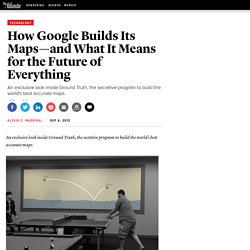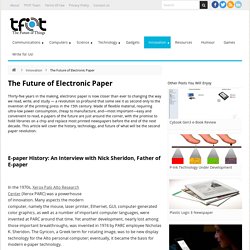Emerging Technologies
> Tech Trends
Ten Awesome Trending Bluetooth Wonders. This Guy Wants Us to Commute in Autonomous, On-Demand Pods. Shocking Facts You Did Not Know A Minute Ago. How Drugs Helped Invent the Internet & The Singularity: Jason Silva on "Turning Into Gods". The Future, as Imagined by Google. How Google Builds Its Maps—and What It Means for the Future of Everything - Alexis C. Madrigal.
An exclusive look inside Ground Truth, the secretive program to build the world's best accurate maps.

Behind every Google Map, there is a much more complex map that's the key to your queries but hidden from your view. The deep map contains the logic of places: their no-left-turns and freeway on-ramps, speed limits and traffic conditions.
Imagining A Future City Filled With Driverless Cars And Without Any Parking Spaces. As self-driving cars move from fantasy to reality, what kind of effect will they have on cities?

A fantastical research and urban prototyping project called Shuffle City investigates, and in the process, becomes a manifesto for a new kind of modern city--one that depends less on traditional public transportation like buses or light rail and more on creating a fleet of continuously moving automated vehicles to serve urban mobility needs. Focusing on Houston--the country’s car-oriented fourth largest city--the project "identifies opportunities outside of the ownership model to liberate an otherwise suppressed urban landscape, by programming a dynamic system of flow that is made more immediately possible through a public autonomous (driverless) vehicle fleet," according to its website. The project wonders: "Is there a new model for American cities, in which mobility can reverse the effect of city centers consumed by the private motor car and its needs?
"
It's Jetsons Time: Driverless Pods Are Taking To The Street In England. In the future, you won't hail a cab or wait at a bus stop.

You'll order a personal pod from your smartphone. Don't believe it? Well, look at Milton Keynes, a sleepy city north of London. It plans to introduce personal transit vehicles starting with a trial in 2015. The pods will carry up to two passengers, plus baggage, from the train station to downtown offices and the shopping district.
Google Data Center Walkthrough. This doohickey turns your normal bike into an electric bike. Watercar the Amphibious Car. The Aluminum Airship of the Future Has Finally Flown. Crazy Hoverbike is Capable of Flying to 10,000 Feet. Even though this crazy hoverbike hasn’t yet left the inventor’s neighborhood, the high-flying invention has some amazing potential.

Designed by Australian Chris Malloy the bike is capable of traveling at speeds of up to 173mph at 10,000 feet. It could potentially travel even higher, but then users would have to carry oxygen. Classified as an ultralight, users won’t be required to have a pilot’s license to ride it, but might we need traffic lanes at 10,000 feet if it does take off? The 1170 cc hoverbike engine is air-cooled and runs on regular unleaded fuel (if only it ran on algae… that would be cool!)
The dune buggy that can fly. In Google Earth.
The Google Earth blog recently posted some examples of how well Google Earth can be used as a scientific visualization platform.

The examples are posted by Thijs Damsma from the OpenEarth Initiative. OpenEarth is the open source initiative to archive, host and disseminate Data, Models and Tools for marine & coastal scientist and engineers. It aims to remedy the above-described inefficiencies by providing a project-superseding approach.
Is This What Urban Buildings Will Look Like In 2050?
In the two weeks since President Donald Trump issued his executive order on immigration, banning travel from seven Muslim-majority countries, he's met with opposition from a surprising sector: the tech industry.

In a radical change of tune since executives like Jeff Bezos and Sheryl Sandberg filed into Trump Tower to meet with the president in December, 128 tech companies have now filed an amicus brief against the ban; the Washington Post reported that Apple CEO Tim Cook said in a company-wide email that the ban "is not a policy we support" and added that "Apple would not exist without immigration.
" While many of these denunciations of Trump's order appear motivated by some higher corporate ethos, there's another factor at play here: pressure from employees.
A new study has taken a step toward measuring the importance of business ethics to young employees (in a very different sector: the apparel and textile industry) and how it could affect retention and on-the-job satisfaction.
The New Second Tallest Building In The World Is An Urban Green Space Wonderland. The second tallest building in the world is more like a vertical city than a building.

The New York Times on TreeHugger Founder's Tiny Apartment and Its "Convertible Tricks"
From folding cars to robotic walls: 5 innovations to make future cities far more livable. Horizontal, cableless elevators to enter testing in 2016. Scientists have created artificial sunlight that’s real enough to trick your brain. 32 Innovations That Will Change Your Tomorrow - Interactive Feature. Electric Clothes.

Trends-technology-timeline-large.jpg (JPEG Image, 2000 × 1405 pixels)
Horizons. Electronic Paper Displays - Readable, Green, Rugged: E Ink. Ultra-efficient LED puts out more power than is pumped in. MIT physicists have been testing a light-emitting diode that has an electrical efficiency of more than 100 percent.

Duke Researchers Develop a New Way to Compress Images. The Future of Electronic Paper. Thirty-five years in the making, electronic paper is now closer than ever to changing the way we read, write, and study — a revolution so profound that some see it as second only to the invention of the printing press in the 15th century.

Made of flexible material, requiring ultra-low power consumption, cheap to manufacture, and—most important—easy and convenient to read, e-papers of the future are just around the corner, with the promise to hold libraries on a chip and replace most printed newspapers before the end of the next decade. This article will cover the history, technology, and future of what will be the second paper revolution.
E-paper History: An Interview with Nick Sheridon, Father of E-paper In the 1970s, Xerox Palo Alto Research Center (Xerox PARC) was a powerhouse of innovation.
German Hackers Are Building a DIY Space Program to Put Their Own Uncensored Internet into Space. There's more than one way to stick it to The Man. There's civil disobedience, subversive propaganda, political art, outright violent revolt--each possessing its own degree of difficulty and consequence. In a decidedly 21st-century twist, team of German hackers bent on fighting the powers that be has chosen a rather ambitious means of taking the power back: building a hacker-owned and -operated space program, complete with a constellation of communications satellites beaming uncensored Internet to users on the ground.
The Transparency Grenade by Julian Oliver (@julian0liver) – Design Fiction for Leaking Data. Electronic Countermeasures @ GLOW Festival NL 2011. Open Source Satellite Initiative. Immortality only 20 years away says scientist. Cheap, Safe, and Fast-Charging: Stanford Reveals Aluminum-Ion Battery Prototype. Researchers demonstrate Stanford’s new aluminum battery. Scientists at Stanford University announced a breakthrough in creating a bendable aluminum battery last week, unveiling a new prototype that could change the face of both hobbyist and professional hardware development.
The new battery charges rapidly, can withstand over 7,500 charging cycles without a drop in capacity, and can generate two volts of electricity—stats that represent a step forward compared to previous generations of the tech. “We have developed a rechargeable aluminum-ion battery that may replace existing storage devices, such as alkaline batteries, which are bad for the environment, and lithium-ion batteries, which occasionally burst into flames,” said Stanford chemistry researcher Hongjie Dai.
“Our new battery won’t catch fire, even if you drill through it.” Scientists have long been intrigued by aluminum batteries due to their low cost and safety advantages over lithium, which can pose a fire hazard.










